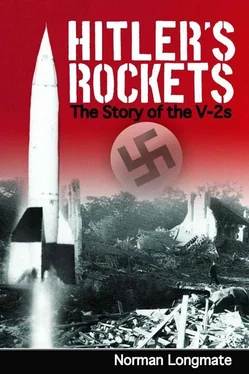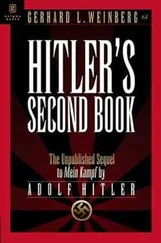Among the printed sources I owe a particular debt to David Irving’s The Mare’s Nest , which deals in detail with the scientific background to the V-2. I hope my book, which concentrates on the subsequent campaign, may to some extent complement his.
Hitler’s Rockets rounds off the series of studies of the British civilian experience between 1939 and 1945 which I began with How We Lived Then , published in 1971. This is a fitting moment, therefore, to thank the several thousand people whose recollections have made them possible and have, I believe, provided an element of first-hand experience which future generations too may find of interest and historical value. I am also grateful to the hundreds of people, many from overseas, who have written to me about already-published works. I am particularly appreciative of those who (invariably with the utmost courtesy and desire to help) have pointed out minor errors of fact which I have subsequently been able to correct.
In writing Hitler’s Rockets I have once again been made aware how uneven were the sacrifices, so far as enemy action was concerned, required from different parts of the country. I feel all the more grateful that by birth, by upbringing and subsequently by choice I belong to that vaguely defined but, during the war, constantly battered area ‘southern England’.
N.R.L.
We had made a beginning.
Major-General Walter Dornberger, recalling December 1934
When in the early evening of Friday, 8 September 1944, two loud explosions echoed across London they caused no particular alarm. The population had become accustomed during five years of war to unexplained noises in the distance, even when, as on this occasion, no warning had sounded. In Whitehall, however, these sudden detonations were not misinterpreted. In many an office ministers, civil servants, government scientists and intelligence officers looked pointedly at each other, aware not merely that a new phase in the bombardment of London, but that a new era in the whole history of warfare, had begun. To the enemy armoury of manned bomber and pilotless aircraft had been added a new and even more formidable weapon, the long-range rocket.
The history of the rocket as a short-range, tactical weapon was in fact longer than that of ordinary firearms. Rockets had been employed by the Chinese in defence of a town besieged by the Mongols in AD 1232, and had been used by a rebellious Indian ruler against the British around 1780. In 1807 the British themselves had employed ‘Congreve’s Rockets’, named after the Colonel Congreve who had developed them, against Boulogne. They made their appearance in the United States during the attack on Fort McHenry, Baltimore, in 1814 and became immortalized in a famous poem later adopted, under a different name, as the United States national anthem:
And the rocket’s red glare;
The bombs bursting in air,
Gave proof through the night
That our flag was still there.
So popular did rockets become during the nineteenth century that they seemed for a time likely to replace conventional artillery, but the development of rifled barrels and more powerful explosives had by 1900 restored the pre-eminence of the field-gun and mortar. Rockets had invariably up to now been battlefield weapons, not used for long-range bombardment, and by far the longest flight of a projectile achieved in the First World War was that of the 25 lb (11.5 kg) shell fired by the ‘Paris Gun’ which between March and July 1918 bombarded the French capital from a range of 75 miles. (To the fury of artillerymen, it was often wrongly described as ‘Big Bertha’, a conventional heavy mortar used on the western front.)
The Treaty of Versailles, by limiting the calibre of weapons with which the future German army, also severely restricted in size, could be equipped, encouraged the Army Weapons Department in Berlin to search for new types of armament which would not violate its provisions while providing the maximum fire power. Numerous articles in technical and popular magazines drew attention to the progress, usually vastly exaggerated, supposedly being made in rocket development. ‘Each individual inventor’, observed one young scientist with a special interest in ballistics, Walter Dornberger, ‘maintained a feud with everyone else who took an interest in rockets’, and to boost their claims to public money the researchers ‘were forced to resort to the inflated language of publicity propaganda’. All this was now to change, for in 1930 the Ballistic Council of the Army Weapons Department selected Dornberger to run its rocket research programme, a post for which he was ideally suited by both background and temperament.
The son of a pharmacist, Walter Dornberger had joined the artillery in August 1914, at the age of nineteen, and served throughout the war, later attending the Berlin Technical Institute before rejoining the army. In 1930 he was a thirty-five-year-old captain, intensely interested in rockets but with his feet firmly on the ground. ‘We wanted’, he wrote later, recalling his first two years of struggling with impractical visionaries, ‘to have done once for all with theory, unproven claims and boastful fantasy and to arrive at conclusions based on a sound scientific foundation.’ During his visits to the airfield in Berlin where the Amateur German Rocket Society carried out its experiments, he was, he later admitted, ‘struck ... by the energy and shrewdness with which’ one ‘tall, fair young student, with a broad, massive chin, went to work and by his astonishing theoretic knowledge’. When General Becker, in charge of the Army Weapons Office, authorized the creation of an expanded research unit, this young man, Werner von Braun, headed Dornberger’s ‘list of proposals for technical assistants’.
Thus began what was to prove one of the classic scientific partnerships of all time. Von Braun’s family were Prussian aristocrats – his father was a former government minister – and his ‘scientific bent’, Dornberger learned, had at first aroused their disgust. Born in March 1912, von Braun developed while at boarding school on the Friesian Islands in the Baltic a passionate interest in astronomy, went on to become a student at the Berlin Technical College, and in 1927 joined the newly formed German Society for Space Travel. By the time he was recruited to Dornberger’s team one important conclusion, which was to have a decisive influence on the whole rocket story, had already been reached. ‘It is not even possible to say with certainty’, wrote Dornberger later, ‘who first gave expression to the idea of using liquids of high energy content instead of powder for propulsion in airless space’ – but this was the first of the giant leaps forward which were to lead to those explosions in London in 1944 and ultimately to the conquest of space.
Hitherto rocket technology had barely progressed since the Chinese had first invented fireworks. The basic principle remained unchanged: the continuous combustion of chemicals in a confined space generated hot gases which, unable to escape except at the rear, forced the rocket forward until they burned out, after which it continued its flight for a time under the thrust already developed. Up to now, however, the weight of fuel needed to achieve the sort of range and payload – i.e. high-explosive warhead – already achieved by ordinary artillery had made the rocket impractical. By using liquid fuel Dornberger hoped to prolong the combustion period and to provide a continuous thrust powerful enough to carry a militarily significant weight far further than any shell so far fired. What, Dornberger rightly saw, was needed was not a single short-lived explosion but an actual motor able to sustain a flight of several minutes at a speed which would carry the missile upwards into space until it curved back to earth at a distance so far unattained by any man-made projectile. Dornberger set his sights initially on a liquid-fuelled engine able to provide a thrust of 650 lb. ‘We meant’, he wrote, ‘to bring this motor to a high level of performance, to gather experience, tabulate laws and principles and so create a basis for further construction.’
Читать дальше






![Traudl Junge - Hitler's Last Secretary - A Firsthand Account of Life with Hitler [aka Until the Final Hour]](/books/416681/traudl-junge-hitler-s-last-secretary-a-firsthand-thumb.webp)





